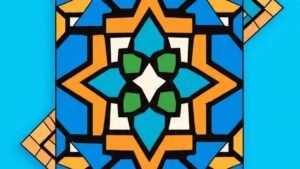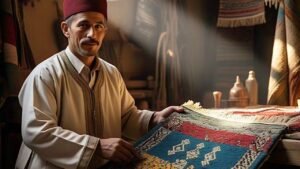
Tracing your fingers over the delicate threads of Moroccan sfifa is akin to stepping into a portal of ancestral memory. You feel its textured elegance, woven not just with silk and gold but with the spirit of countless hands. Its intricate patterns whisper stories of celebration, devotion, and artistry that stretch across centuries. In a dimly lit souk, artisans sit with quiet pride, their craft echoing the resilience of Moroccan heritage. Moroccan sfifa is not merely an embellishment; it is the heartbeat of tradition, binding fabrics, families, and culture in an embrace that defies time.
Woven Whispers: The History of Moroccan Sfifa

In the labyrinth of Moroccan culture, sfifa emerges as both an artifact and an art form. Its origins can be traced back to the Andalusian era of the 9th century, when Moorish refinement blended seamlessly with Islamic artistry to create something profoundly intricate. Over centuries, sfifa evolved, growing in complexity while remaining steadfastly rooted in the traditions that birthed it. This artistry, passed through the hands of Morocco’s artisans, tells not just the story of its makers but also of Morocco itself, from its vibrant souks to its royal courts.
Sfifa’s significance lies not just in its physical beauty but in its symbolic resonance. During the reign of the Merinid dynasty, it adorned garments worn by the elite, marking status and lineage. Even today, these threads carry the weight of history, weaving together the past and present. Each piece of sfifa is a chronicle, its designs carrying elements of geometry, spirituality, and Moroccan identity.
The threads themselves are imbued with meaning. Whether crafted from luxurious silk, shimmering gold, or humble cotton, sfifa transforms the ordinary into the extraordinary. Every stitch is a labor of love, and every strand a testament to the artisan’s devotion. Sfifa is not merely fabric; it is an heirloom, a living thread connecting generations.
Moroccan Sfifa in Ceremonial Splendor

When the folds of a Moroccan caftan shimmer under the sun, adorned with sfifa, it becomes more than clothing—it becomes a living story. Sfifa is synonymous with life’s grand occasions, gracing the edges of djellabas and kaftans with a beauty that feels sacred. Each thread, woven with precision, tells of moments that are as fleeting as they are profound.
In weddings, sfifa is not merely an accessory; it is the centerpiece. The bride, draped in a gown edged with gleaming threads, is a vision of tradition and hope. Her caftan, often adorned with intricate aqad (knots) and rzim (buttons), represents countless hours of artistry and care. Families take pride in these garments, not just for their aesthetic value but for the history they carry. “When we wear sfifa,” says Laila, a young bride from Marrakech, “we are wearing more than beauty. We are wearing our ancestors’ dreams.”
Sfifa’s role extends beyond weddings. It is a constant presence in Morocco’s rites of passage, from the birth of a child to the solemnity of funerals. In each instance, sfifa frames the occasion, offering a quiet sense of continuity. Its threads, delicate yet unyielding, remind us that life’s moments are stitched together by tradition, celebration, and the bonds of family.
The Artisans Behind the Threads of Moroccan Sfifa

To truly understand Moroccan sfifa is to meet the artisans whose lives are entwined with its creation. In a small workshop in Rabat, the scent of beeswax mingles with the hum of spinning wheels. Fatima, an artisan in her fifties, dips a thread into golden dye, her hands steady and deliberate. “This craft is my prayer,” she says, her voice soft but resolute. “Each thread must carry beauty, or it carries nothing at all.” For Fatima and countless others like her, sfifa is not just a livelihood; it is a calling.
Artisans like Fatima begin their journey as children, apprenticed to their elders in workshops that feel more like sanctuaries. They learn not just the technical skills of weaving but the rhythms of patience, focus, and reverence. The process is painstaking. Threads are dyed in small batches, often by hand, and then woven and embroidered using tools that have remained unchanged for centuries. Modern machinery cannot replicate the artistry of human hands, the imperfections that give each piece of sfifa its soul.
Yet, the lives of these artisans are far from idyllic. In the face of globalization and fast fashion, their craft is under threat. Markets are flooded with imitations, cheaper but devoid of spirit. Still, artisans persevere. “Sfifa is my language,” says Ahmed, a weaver from Tetouan. “Even if no one listens, I must continue speaking it. Without it, I am silent.” Their resilience ensures that sfifa remains not just a tradition but a living, breathing art form.
Sfifa in Modern Moroccan Design

While sfifa is steeped in tradition, it is far from static. Contemporary Moroccan designers have embraced this ancient craft, infusing it with modernity and expanding its reach. Today, sfifa graces not just traditional garments but also handbags, shoes, and even furniture, showcasing its versatility and timeless appeal.
In Casablanca, a boutique run by the young designer Samira displays jackets edged with sfifa. The intricate detailing contrasts with minimalist cuts, creating a harmonious blend of past and present. “Sfifa is more than decoration,” Samira explains. “It’s a thread that connects us to our roots while allowing us to dream of the future.” Such modern interpretations of sfifa allow it to transcend its origins, finding a place in global fashion while maintaining its identity.
Among these innovations, sfifa bracelets have become symbols of understated elegance. Crafted with the same meticulous care as larger pieces, these bracelets coil around the wrist like a delicate tapestry. Their vibrant threads and intricate braids are an ode to the artistry of Moroccan culture. Popular both within Morocco and abroad, these bracelets carry the essence of the souk, the artisan, and the history of sfifa in a single, wearable form.
The Cultural Legacy of Moroccan Sfifa

Moroccan sfifa is more than an adornment; it is a cultural lexicon. Its patterns are a language of belonging, its colors a palette of identity. Through sfifa, Morocco speaks—to its people and to the world.
Even in diaspora communities, sfifa remains a touchstone. Moroccan families abroad treasure garments edged with sfifa, preserving them as heirlooms. These threads become bridges, tethering them to their roots and heritage. Nawal, a second-generation Moroccan in Paris, speaks of her grandmother’s sfifa-edged djellaba: “When I see it, I don’t just see fabric. I see the hands that made it, the stories it holds. It reminds me who I am.”
In a world increasingly homogenized, Moroccan sfifa stands as a beacon of individuality. It resists the tide of forgetfulness, holding firm to the traditions it represents. Each thread tells a story, each stitch preserves a moment. Sfifa reminds us that beauty is not fleeting, that the past need not be left behind but carried forward, one thread at a time.




